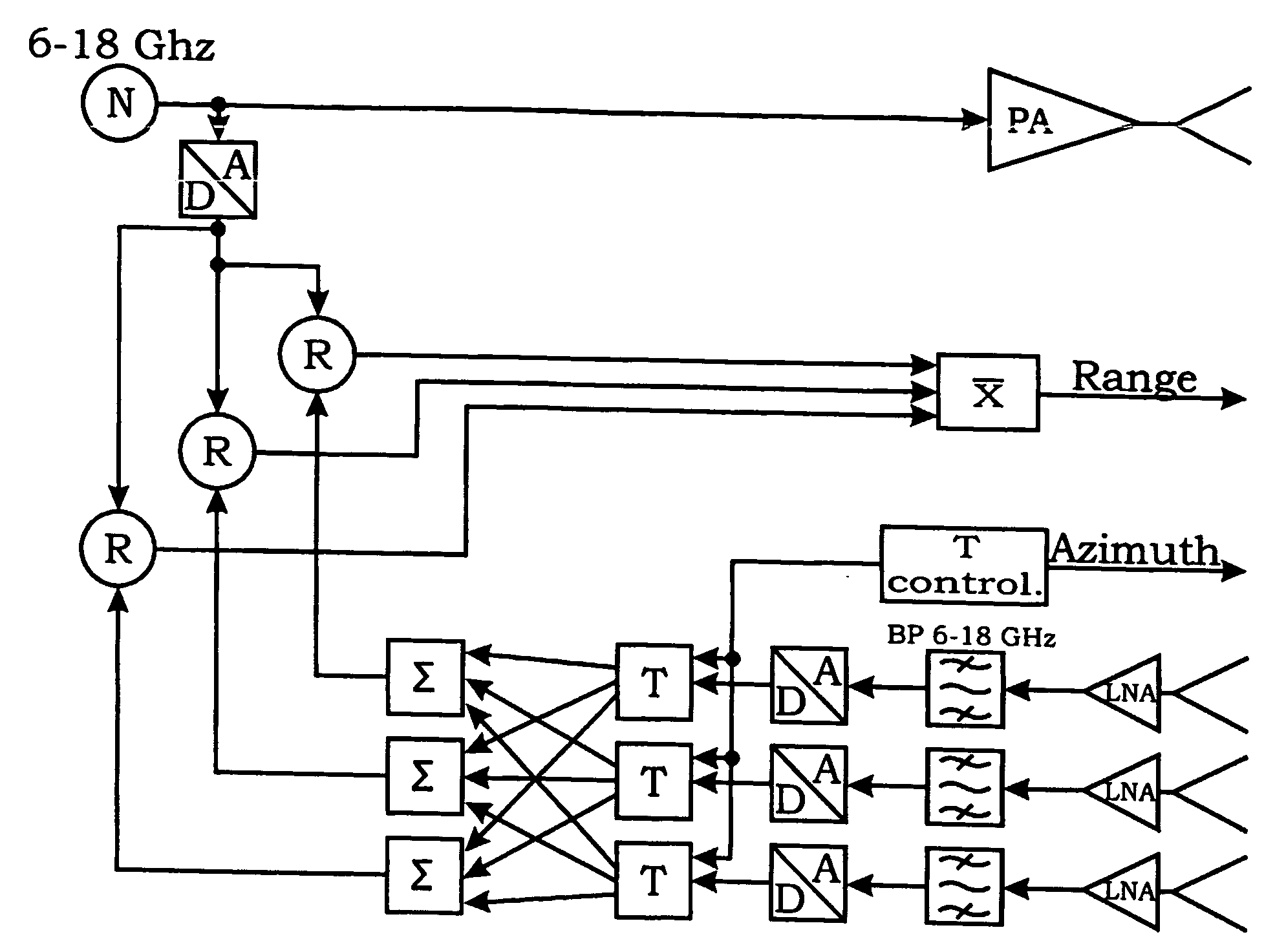Method and system for unambiguous angle resolution of a sparse wide-band antenna array
a wide-band antenna array and sparse technology, applied in the field of wide-band antenna arrays, can solve the problems of complex array antennas having unsatisfactory angle resolution, and complex array antennas with a large number of elements, and achieve the effect of avoiding the formation of complex array antennas, reducing the complexity of array antennas, and reducing the cost of array antennas
- Summary
- Abstract
- Description
- Claims
- Application Information
AI Technical Summary
Problems solved by technology
Method used
Image
Examples
second embodiment
[0033] For the present invention assume a circular array having the main lobe of each antenna element pointing in a radial direction and according to Equation (10) has the simple frequency independent shape: EL(θ)=|cos(θ)ifcos(θ)>00ifcos(θ)≤0(10)
[0034] The sum, from all n receiving antennas then can be written according to Equation (11): EΣ(θ)=∑n=0N-1e(t-2·Rc0+τn(ϕ)-τn(θ))·EL(θ-n·2πN)(11)
[0035] R, φ are distance and bearing to the target, respectively, and θ is the current antenna search angle. Time corrections τn are calculated according to Equation (12): τn(ϕ)=D2·c0·cos(ϕ-n·2πN)(12)
[0036] Expected value of the antenna diagram AP(θ, φ) is calculated according to Equation (13):
AP(θ,φ)=10·log{E[EΣ2(θ,φ)]} (13)
[0037] Then, we can perform the following calculation: E[EΣ2(θ,ϕ)]=E[(∑n=0N-1e(t-2·Rc0+τn(ϕ)-τn(θ))·EL(θ-n·2πN))2]=E[∑n=0N-1e(t-2·Rc0+τn(ϕ)-τn(θ))·EL(θ-n·2πN)·∑m=0N-1e(t-2·Rc0+τm(ϕ)-τm(θ))·EL(θ-m·2πN)]=E[∑n=0N-1∑m=0N-1e(t-2·Rc0+τn(...
third embodiment
[0038] In yet a third embodiment the antenna array may well be formed as a conformal array and calculated in a similar way corresponding to the above examples of the linear and circular array.
Simulations
[0039]FIG. 3 demonstrates the auto-correlation function for white bandwidth limited noise according to equation (5). As can be seen a bandwidth of 100% is needed to get the sidelobes down to a reasonable level.
[0040] For the simulations 100% bandwidth and a center frequency of 12 GHz was chosen. In other words the frequency range of the radar was 6-18 GHz. The distance to the target is determined by finding the peaks of the convolution between input and output signal.
[0041]FIG. 4 illustrates a simulation result when signal-to-noise was varied. In this case the target is an object, 1 meter long, standing still at a distance of 750 meters. The target area as function of distance is an equally distributed random number per distance sample. The sampling rate in this case was 50 GHz. ...
PUM
 Login to View More
Login to View More Abstract
Description
Claims
Application Information
 Login to View More
Login to View More - R&D
- Intellectual Property
- Life Sciences
- Materials
- Tech Scout
- Unparalleled Data Quality
- Higher Quality Content
- 60% Fewer Hallucinations
Browse by: Latest US Patents, China's latest patents, Technical Efficacy Thesaurus, Application Domain, Technology Topic, Popular Technical Reports.
© 2025 PatSnap. All rights reserved.Legal|Privacy policy|Modern Slavery Act Transparency Statement|Sitemap|About US| Contact US: help@patsnap.com



